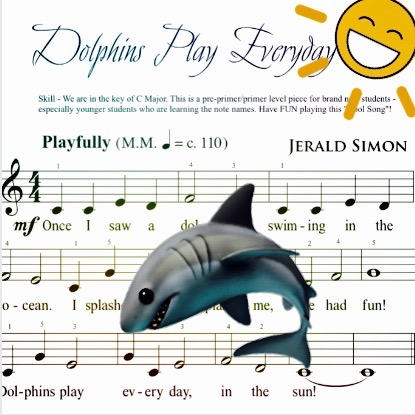Baroque Dolphins vs. Sharks

My 7 year old student, Gini, grinned at me as she neared the end of Dolphins Play Everyday. She suddenly played a huge handful of low bass keys and wiggled her eyebrows. “Big wave?,” I asked. “No,” she answered, “Shark.” What did we do next? I’ll get to that in a minute.
So, how did I ever get involved with dolphins and sharks? Dolphins Play Everyday is one of the pieces included in Jerald Simon’s new 130 page resource. I have been having a blast exploring the 30 pieces, lessons in jazz, composing, improv, and more, plus his book 20 Ways to Motivate Teen Piano Students. Jerald’s pieces are inspired by his students and many were even created as a result of a student challenge!
Back to the ocean and a certain 7 year old. After the shark attack, I grinned back at Gini and I played a glissando from middle C to the top of the keyboard. Her eyes got big, “She got away!” Immediately she wanted to play a glissando too. So, I pulled out the heavy piece of folded cardboard I keep handy so little hands can gliss to their hearts content without injury. A shark dolphin chase illustrated with low and high glissandos and much laughing.
This week I plan to introduce this piece as a canon. We can have a different kind of shark dolphin chase. I’ll have Gini be the dolphin and start the piece. When she is at measure 5, the shark (that’s me) will come in a low register and chase her. There are two D/E dissonances when you play it this way but they are not terribly serious especially when separated by a couple octaves. Probably some note clusters and glissandos will also happen. Eventually, I hope to reverse our musical roles and get dolphin Gini to do some shark chasing.
Taking elementary pieces and playing them as canons is great preparation for Baroque contrapuntal voicing. You’ll find that a lot of pieces work beautifully once you start looking. Early level students don’t know it is hard. They never cease to surprise me with their ability to keep going no matter that I’m playing something different. Yes, there might be a few train wrecks but they always have a ball and get the hang of it in the end. It also helps if I play very quietly in the beginning so they can focus on their part.
The ability to be creative and spontaneous is why I love Jerald Simon’s music. Students of all levels love it too. He began writing to keep a group of his teen students from quitting lessons. Not only did he keep those students playing piano but he has since motivated countless students in studios across the country to take joy in their lessons. These pieces and resources are definitely not uni-taskers.


